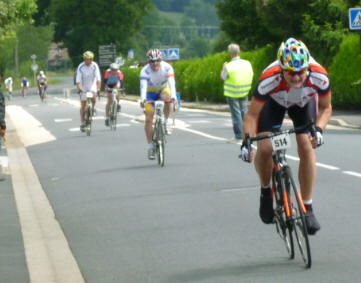How Do I ~ Win a Sprint?
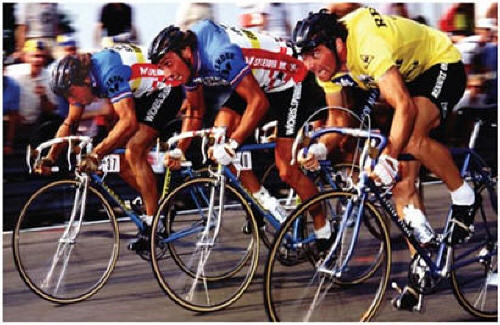
When this photo first
came out it was my favourite ever.
Over thirty years later, it still is...
Okay, you've made the cut; the break's gone up the road and been brought back; the chancers have attacked, had their glory off the front and have been reeled in for the final five k run in; you're going under the flamme rouge, you're fifth wheel and it's all going to kick off in around a minute's time. What now...?
Good question well asked. We'll come back to it later.
The Perfect Storm
Apart from the obvious recommendation of
ensuring you have the necessary physiology, have done the necessary
sprint training drills, the necessary preparation, and have the "bottle" to mix it
when it gets leery (all of which are covered in
this factsheet), then there are certain ethereal elements you need to bring
together to extol a perfect sprint.
Knowledge, Tactics, Timing & Technique are the four critical pre-requisites to a top step on the podium. Any three of the four and you'll get a podium place, but you'll need all of them if you're going to get to kiss the girls (or boys) and walk away with the spoils.
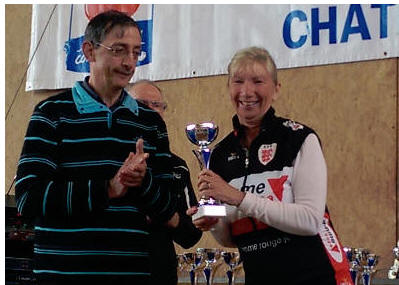
Madame flamme rouge
taking first lady for the third time,
from prize presenter
Milan San Remo winner, Marc Gomez
Knowledge
There will be things you know and things you
don't know. Once again I'm stating the blinding obvious; so what does
that asinine statement actually mean?
You know how you feel, you know how well you've trained and you know how hard you've worked to be in the finale of your chosen event. You've earned your place for the final showdown and deserve to be there as much as anyone else.
You also know you're going to give it everything you've got and go for the win. If you're in any doubt whatsoever about the win, or have the slightest lack of confidence, you don't belong there. Get out of the way you could get hurt, or worse still, hurt someone else.
Normally I avoid, cliché's like the plague (see what I did there?), but in sprinting fortune really does favour the brave. To win, you have to be prepared to lose. You either do this with 100% commitment or not at all. Come on, we're flamme rougers, it's glory or death! What a drama queen!
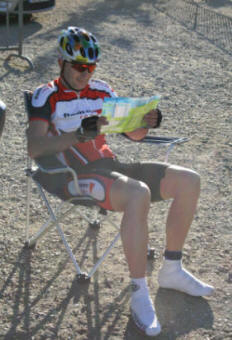
Things knowable...
You need to maximise the knowledge you have and make best use of the
information you can find.
It's very, very rare that I do an event twice. So it's important that I gen up on routes and environments before I leave for, and when I get to, the event.
Study the race profile and find the key points.
Are there any hills in the last 10k, are there any corners or roundabouts in the last kilometre? Check to see if there is any street furniture on the run in to the line; are there any ripples of tarmac or pot holes that should be avoided, which way is the wind blowing?
You're looking to isolate anything that can affect the outcome of your ability to be in the mix at the end of the race, or get a clear run in to the finish line?
Find the exact race distance and make sure you remember it for the countdown on your Garmin, SRM display or cycle computer of choice. Please don't say you don't have one.
How can you have a race strategy if you don't know how far you've travelled or how far there is to go to the finish line? These tools aren't for show, they're as much an aid to your race win as the pedals on your bike. Even a £10 Cateye will do the trick.
If you're driving to the event, try to drive the last 10k of the route on the morning or day before. Just familiarise yourself with landmarks; is there a church, or shop, or garage, with 5k to go etc.
Ride, if you can, the last kilometre as part of your pre-event warm up and check for the above mentioned pot-holes, gravel, wind direction, gradient, trees, pinch-points and crossings (as above), parked cars, blocked exits after the line, etc, etc. Look for a significant building, tree or landmark that marks the 200 metre board, like the veterinarian surgery in the sprint shot below.
If you think you're going to be in with a shout at the finish, nothing should come as a surprise . Even if you're in a sportive and sprinting for the kudos of "your group's" line-honours, don't leave it to chance. Do your homework. There is no excuse for not finding any of this vital, race winning information, on the day.
Things not yet known...
Now we come to the stuff you don't know, or
at least don't yet know. Racing in Europe means there is little chance of
knowing who's who in any of the events you do; especially with a field
like the one below. But that doesn't
mean you can't find out who the players are while the event is in progress.
Pay
attention.
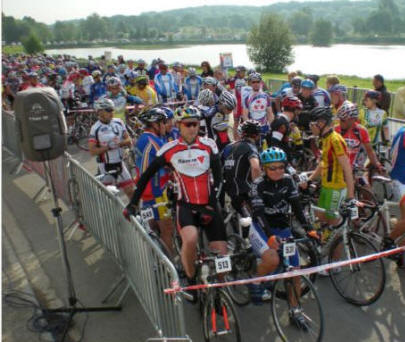
Look for the strong boys in the group. The quiet ones who go about their work, do a turn then drift to the back. When a gap opens, they close it slowly without any fuss or drama.
They're the race-winning strong ones. They're doing their best not to show their hand. There's no shouting, no gesticulating, no wasting of energy, nothing that will draw your attention to them. This is a purposeful strategy. They're not being shy! Keep an eye on them and nonchalantly hold their wheel, and keep others off it. Always.
Ignore those that are screaming at people to come through, who ride off the front showing how "hard" they are. Climbing off the front and attacking over the top on the early hills. They're shamateurs, trying to intimidate others in to showing their hands. Keep your powder dry, wait for the quiet ones to go, then go with them. But go quietly.
Tactics
When it comes to the finale, using the
knowledge you've gained during the preceding 100 or so kilometres of
racing, pick the wheel you've identified. Ideally, in the last
10k, you're looking for the biggest "strong, quiet rider" you can find.
This is the person that's going to give you an armchair ride to the finish. They'll close the gaps, shelter you from the wind and keep you out of trouble. Don't overplay your hand. Remember, they don't know anything about you, so feign fatigue, keep a worried look on your face and "struggle" to hold wheels and close gaps.
You don't want to be near, or on the front in the last five kilometres. If it starts looking like you're getting dangerously close to the sharp end, allow a two bike length gap to open up. Just make sure you're not dropped. Two bike lengths, will force the nervous people to come around you and fill the gap or they think they'll get distanced.
If no one comes through, let a ten length gap open, then semi-sprint to close it but "fatigue" and gently sit up half way. Those reacting to your jump will come around you filling the gap. Job done.
Hold your nerve. And don't wave your elbow like a one-armed albatross. No one will come through if you look like you're trying too hard to force the issue. They'll wait until a twenty bike length gap opens, then sprint it and before you know it, you're riding in alone.
As you enter the last kilometre you want to be fifth wheel. Holding it should become an instinct. Whatever you do, you hold this position as though your life (it's only a pyrrhic victory but sometimes it has the same perceived value) depends on it.
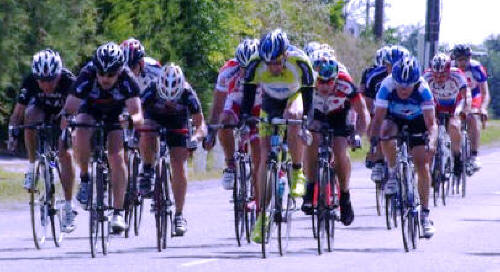
Find the sweet spot and sit there behind the biggest rider. Don't let the wheel go, don't give a chance to someone else to take it, and don't get muscled off it. Sit there, stay calm, stay focused, keep your elbows out, stay out the wind, stay aero and save energy. Whatever you do, don't let yourself get shuffled to the front!
Let the others waste energy going up and down the line (the three riders in black on the left). Having said that, there's only one thing worse than being on the front and that's being boxed in at the back. If it looks like a train is moving up the outside, make sure you're in it.
No need for dramatics, or switching, or lurching to the side and putting the whole group at risk. If you're in the sweet spot, you just pick up your revs and ease out of the pocket in to the line. This, like every other cycle skill you cultivate, should become an instinct. If you have to think about it, it's too late,
Your sole objective for the previous, however long the event is, is to arrive at the flamme rouge fresher than everyone else, with your ATP and Phosphate Creatine stores intact.
The old adage of "never take a sprinter to the line" is legendary for a reason. It doesn't matter how exhausted a sprinter is, they can always sprint at the end of the race. It's in their genes, it's hardwired in to their DNA and their ATP PC stores. A tired sprinter will always beat a strong non-sprinter; always.
Timing
Which brings us to timing. Timing is
everything, and it all starts with how long can you sprint for? If
you don't instinctively know the answer to this question, then you're not going to win a sprint
victory any time soon!
There is an accompanying factsheet to this, on how to train for a sprint. One of the things it covers is, determining how long you can sprint for, how much power you put out, for how long, to reach your terminal speed. If your maximum terminal acceleration distance is 180 metres, there's no point jumping at the 250 metre to go board. Close, but no cigar.
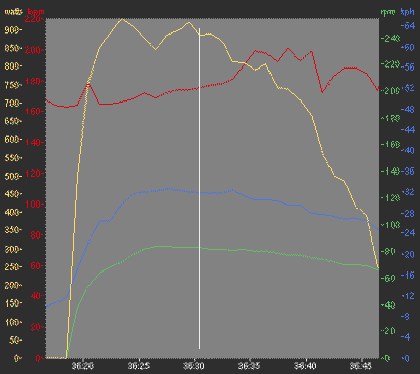
Here's a 25 second sprint, look at the drop off after 20 seconds...
Also, if you take 80 metres to get up to your terminal velocity, there's no point "jumping" with 50 metres to go. Timing, as with everything in life, is crucial to success. But rule number one is, leave it as late as you dare. But not too late.
Most people panic and sprint far too early, die 30 metres before the line then get swamped. If this happens to you regularly, then you need to start your sprint 30 metres later, or train to sprint 30 metres longer.
Again, this sounds an obvious statement to make. But you'll not believe how many people I regularly see sprint too early, get caught, then do the same thing the following week. Hoping that one week it will pay off. I've said it elsewhere many times on this site; madness is constantly repeating the same actions and expecting a different outcome to that previously experienced. Have a word...
Enough for Now
Instructions on finding the correct sprinting point (for you),
and other gems that will help you with your training and technique, are in the
aforementioned factsheet.
For now, absorb the above, start putting it in to practice and enjoy the crazy, unbeatable adrenaline rush that is a full on race sprint.
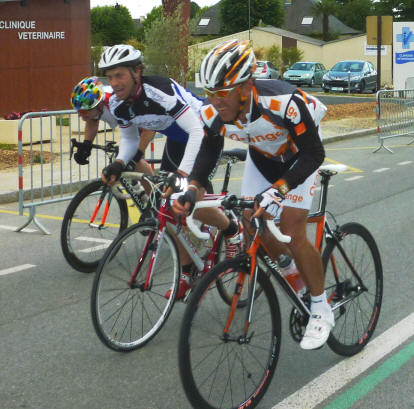
flamme rouge interpretation
of the classic photo at the top of the page
I'm far side, in the drops, out of the wind, crouched low and starting to wind it up with 100m to go.
The Message
As we've said before, there are three types of people in this
world...
▼ Those that let things happen
▼ Those that make things happen and
▼ Those that say "What happened?"
There are no prizes for being on the front for the first 150 kilometres or so; only the last five metres count. There are no prizes for watching the sprint unwind and thinking, I should be going with that. And there are no prizes for cracking, going up the road and dying twenty metres from the line.
And the difference between all three is a little bit of knowledge and the blink of an eye.
Until next time my little gladiators...

